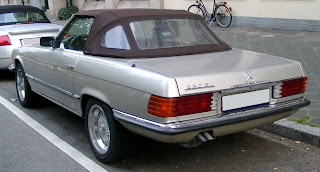The 1959 Cadillac is remembered for its huge sharp tailfins with dual bullet tail lights, two distinctive rooflines and roof pillar configurations, new jewel-like grille patterns and matching deck lid beauty panels. In 1959 the Series 62 became the Series 6200. De Villes and 2-door Eldorados were moved from the Series 62 to their own series, the Series 6300 and Series 6400 respectively, though they all, including the 4-door Eldorado Brougham (which was moved from the Series 70 to Series 6900), shared the same 130 in (3,302 mm) wheelbase.
Engine output was an even 325 hp (242 kW) from the 390 cu in (6.4 L) engine. The Series 6200 was identifiable by its straight body rub moldings, running from front wheel opening to back bumpers, with crest medallions below the spear. A one-deck jeweled rear grille insert was seen. Standard equipment included power brakes, power steering, automatic transmission, back-up lamps, windshield wipers, two-speed wipers, wheel discs, outside rearview mirror, vanity mirror and oil filter. The convertible model had power windows and a two-way power seat. Plain fender skirts covered the rear wheels and 4-doors were available in either four-window or six-window hardtop configurations. With the De Villes and 2-door Eldorados in their own series sales plunged to only 70,736, the lowest since the 1950 model year.
The 1960 Series 6200 had smoother, more restrained styling. General changes included a full-width grille, the elimination of pointed front bumper guards, increased restraint in the application of chrome trim, lower tailfins with oval shaped nacelles and front fender mounted directional indicator lamps. Series 6200 were distinguished by plain fender skirts, thin three-quarter length bodyside spears and Cadillac crests and lettering on short horizontal front fender bars mounted just behind the headlights.
Four-window and six-window hardtop sedans were offered again. The former featured a one-piece wraparound backlight and flat-top roof, while the latter had a sloping rear window and roofline. Standard equipment included power brakes, power steering, automatic transmission, dual back-up lamps, windshield wipers, two-speed wipers, wheel discs, outside rearview mirror, vanity mirror and oil filter. The convertible model had power windows and a two-way power seat.
Technical highlights were finned rear drums and an X-frame construction. Interiors were done in Fawn, Blue or Gray Cortina Cord or Turquoise, Green, Persian Sand, or Black Caspian cloth with Florentine vinyl bolsters. Convertibles were upholstered in Florentine leather single or two-tone combinations or monochromatic Cardiff leather combinations.
1950 Oldsmobile 88 | ||
1957 Lincoln Premiere | ||
1955 Mercury Montclair | 1958 Continental Mark III | |
1951 Rambler Custom Landau | 1956 Ford Thunderbird | |
1953 Oldsmobile Fiesta | 1959 Cadillac Series 62 | |
1954 Hudson Hornet Brougham | 1956 Packard Caribbean | 1959 Dodge Custom Royal |
1957 Chevrolet Bel Air | ||
1955 Buick Century | 1957 Chrysler New Yorker |
| Fiat V8 , Fiat Supersport |











































